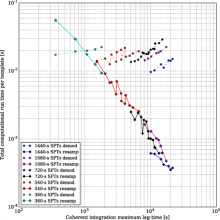
Abstract
Continuous-wave (CW) gravitational waves (GWs) call for computationally-intensive methods. Low signal-to-noise ratio signals need templated searches with long coherent integration times and thus fine parameter-space resolution. Longer integration increases sensitivity. Low-mass x-ray binaries (LMXBs) such as Scorpius X-1 (Sco X-1) may emit accretion-driven CWs at strains reachable by current ground-based observatories. Binary orbital parameters induce phase modulation. This paper describes how resampling corrects binary and detector motion, yielding source-frame time series used for cross-correlation. Compared to the previous, detector-frame, templated cross-correlation method, used for Sco X-1 on data from the first Advanced LIGO observing run (O1), resampling is about 20× faster in the costliest, most-sensitive frequency bands. Speed-up factors depend on integration time and search setup. The speed could be reinvested into longer integration with a forecast sensitivity gain, 20 to 125 Hz median, of approximately 51%, or from 20 to 250 Hz, 11%, given the same per-band cost and setup. This paper’s timing model enables future setup optimization. Resampling scales well with longer integration, and at 10× unoptimized cost could reach respectively 2.83× and 2.75× median sensitivities, limited by spin-wandering. Then an O1 search could yield a marginalized-polarization upper limit reaching torque-balance at 100 Hz. Frequencies from 40 to 140 Hz might be probed in equal observing time with 2× improved detectors.